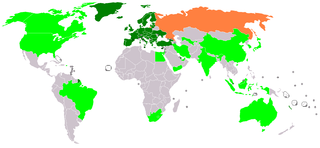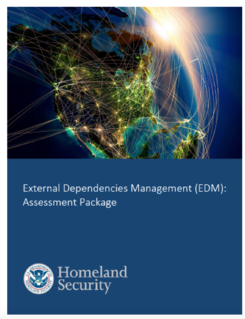Related Research Articles
The Capability Maturity Model (CMM) is a development model created in 1986 after a study of data collected from organizations that contracted with the U.S. Department of Defense, who funded the research. The term "maturity" relates to the degree of formality and optimization of processes, from ad hoc practices, to formally defined steps, to managed result metrics, to active optimization of the processes.

IT security standards or cyber security standards are techniques generally outlined in published materials that attempt to protect the cyber environment of a user or organization. This environment includes users themselves, networks, devices, all software, processes, information in storage or transit, applications, services, and systems that can be connected directly or indirectly to networks.
Threat modeling is a process by which potential threats, such as structural vulnerabilities or the absence of appropriate safeguards, can be identified, enumerated, and mitigations can be prioritized. The purpose of threat modeling is to provide defenders with a systematic analysis of what controls or defenses need to be included, given the nature of the system, the probable attacker's profile, the most likely attack vectors, and the assets most desired by an attacker. Threat modeling answers questions like “Where am I most vulnerable to attack?”, “What are the most relevant threats?”, and “What do I need to do to safeguard against these threats?”.
Prelude SIEM is a Security information and event management (SIEM).

ETSI is an independent, not-for-profit, standardization organization in the field of information and communications. ETSI supports the development and testing of global technical standards for ICT-enabled systems, applications and services.

Security information and event management (SIEM) is a field within the field of computer security, where software products and services combine security information management (SIM) and security event management (SEM). They provide real-time analysis of security alerts generated by applications and network hardware. Vendors sell SIEM as software, as appliances, or as managed services; these products are also used to log security data and generate reports for compliance purposes. The term and the initialism SIEM was coined by Mark Nicolett and Amrit Williams of Gartner in 2005.

An information security operations center is a facility where enterprise information systems are monitored, assessed, and defended.
The Open Smart Grid Protocol (OSGP) is a family of specifications published by the European Telecommunications Standards Institute (ETSI) used in conjunction with the ISO/IEC 14908 control networking standard for smart grid applications. OSGP is optimized to provide reliable and efficient delivery of command and control information for smart meters, direct load control modules, solar panels, gateways, and other smart grid devices. With over 5 million OSGP based smart meters and devices deployed worldwide it is one of the most widely used smart meter and smart grid device networking standards.
Network functions virtualization (NFV) is a network architecture concept that leverages the IT virtualization technologies to virtualize entire classes of network node functions into building blocks that may connect, or chain together, to create and deliver communication services.

Gabriel "Gabi" Siboni is a colonel in the Israel Defense Forces Reserve service, and a senior research fellow and the director of the Military and Strategic Affairs and Cyber Security programs at the Institute for National Security Studies. Additionally, he serves as editor of the tri-yearly published, Military and Strategic Affairs academic journal at INSS. Siboni is a senior expert on national security, military strategy and operations, military technology, cyber warfare, and force buildup. Siboni is as a Professor at the Francisco de Vitoria University in Madrid.
The Cyber Resilience Review (CRR) is an assessment method developed by the United States Department of Homeland Security (DHS). It is a voluntary examination of operational resilience and cyber security practices offered at no cost by DHS to the operators of critical infrastructure and state, local, tribal, and territorial governments. The CRR has a service-oriented approach, meaning that one of the foundational principles of the CRR is that an organization deploys its assets to support specific operational missions. The CRR is offered in a facilitated workshop format and as a self-assessment package. The workshop version of the CRR is led by a DHS facilitator at a critical infrastructure facility. The workshop typically takes 6–8 hours to complete and draws on a cross section of personnel from the critical infrastructure organization. All information collected in a facilitated CRR is protected from disclosure by the Protected Critical Infrastructure Information Act of 2002. This information cannot be disclosed through a Freedom of Information Act request, used in civil litigation, or be used for regulatory purposes. The CRR Self-Assessment Package allows an organization to conduct an assessment without the need for direct DHS assistance. It is available for download from the DHS Critical Infrastructure Cyber Community Voluntary Program website. The package includes an automated data answer capture and report generation tool, a facilitation guide, comprehensive explanation of each question, and a crosswalk of CRR practices to the criteria of the National Institute of Standards and Technology (NIST) Cybersecurity Framework. The questions asked in the CRR and the resulting report are the same in both versions of the assessment. DHS partnered with the CERT Division of the Software Engineering Institute at Carnegie Mellon University to design and deploy the CRR. The goals and practices found in the assessment are derived from the CERT Resilience Management Model (CERT-RMM) Version 1.0. The CRR was introduced in 2009 and received a significant revision in 2014.
Threat Intelligence Platform is an emerging technology discipline that helps organizations aggregate, correlate, and analyze threat data from multiple sources in real time to support defensive actions. TIPs have evolved to address the growing amount of data generated by a variety of internal and external resources and help security teams identify the threats that are relevant to their organization. By importing threat data from multiple sources and formats, correlating that data, and then exporting it into an organization’s existing security systems or ticketing systems, a TIP automates proactive threat management and mitigation. A true TIP differs from typical enterprise security products in that it is a system that can be programmed by outside developers, in particular, users of the platform. TIPs can also use APIs to gather data to generate configuration analysis, Whois information, reverse IP lookup, website content analysis, name servers, and SSL certificates.
The Co-Managed IT security service model entails security monitoring, event correlation, incident response, system tuning, and compliance support across an organization's entire IT environment. Co-Management allows organizations to collaborate with their managed security service providers by blending security expertise of the provider with the contextual knowledge of the customer to optimise security posture.
Cyber threat hunting is an active cyber defence activity. It is "the process of proactively and iteratively searching through networks to detect and isolate advanced threats that evade existing security solutions." This is in contrast to traditional threat management measures, such as firewalls, intrusion detection systems (IDS), malware sandbox and SIEM systems, which typically involve an investigation of evidence-based data after there has been a warning of a potential threat.

The External Dependencies Management Assessment is a voluntary, in-person, facilitated assessment created by the United States Department of Homeland Security. The EDM Assessment is intended for the owners and operators of critical infrastructure organizations in the United States. It measures and reports on the ability of the subject organization to manage external dependencies as they relate to the supply and operation of information and communications technology (ICT). This area of risk management is also sometimes called Third Party Risk Management or Supply Chain Risk Management.
A blue team is a group of individuals who perform an analysis of information systems to ensure security, identify security flaws, verify the effectiveness of each security measure, and to make certain all security measures will continue to be effective after implementation.
NIST Cybersecurity Framework is a set of guidelines for mitigating organizational cybersecurity risks, published by the US National Institute of Standards and Technology (NIST) based on existing standards, guidelines, and practices. The framework "provides a high level taxonomy of cybersecurity outcomes and a methodology to assess and manage those outcomes", in addition to guidance on the protection of privacy and civil liberties in a cybersecurity context. It has been translated to many languages, and is used by several governments and a wide range of businesses and organizations.
The Center for Internet Security (CIS) is a 501(c)(3) nonprofit organization, formed in October, 2000. Its mission is to make the connected world a safer place by developing, validating, and promoting timely best practice solutions that help people, businesses, and governments protect themselves against pervasive cyber threats. The organization is headquartered in East Greenbush, New York, with members including large corporations, government agencies, and academic institutions.
NGSI-LD is an information model and API for publishing, querying and subscribing to context information. It is meant to facilitate the open exchange and sharing of structured information between different stakeholders. It is used across application domains such as Smart Cities, Smart Industry, Smart Agriculture, and more generally for the Internet of Things, Cyber-Physical Systems, Systems of systems and Digital Twins.
Cybersecurity Capacity Maturity Model for Nations (CMM) is a framework developed to review the cybersecurity capacity maturity of a country across five dimensions. The five dimensions covers the capacity area required by a country to improve its cybersecurity posture. It was designed by Global Cyber Security Capacity Centre of university (GCSCC) of University of Oxford and first of its kind framework for countries to review their cybersecurity capacity, benchmark it and receive recommendation for improvement. Each dimension is divided into factors and the factors broken down into aspects. The review process includes rating each factor or aspect along five stages that represents the how well a country is doing in respect to that factor or aspect. The recommendations includes guidance on areas of cybersecurity that needs improvement and thus will require more focus and investment. As at June, 2021, the framework has been adopted and implemented in over 80 countries worldwide. Its' deployment has been catalyzed by the involvement of international organizations such as the Organization of American States (OAS), the World Bank (WB), the International Telecommunications Union (ITU) and the Commonwealth Telecommunications Union (CTO) and Global Forum on Cyber Expertise (GFCE).
References
- ↑ ETSI GS ISI 001-1 (V1.1.2): ISI Indicators Part 1; A full set of operational indicators for organizations to use to benchmark their security posture (2015-06)
- ↑ ETSI GS ISI 001-2 (V1.1.2): ISI Indicators Part 2; Guide to select operational indicators based on the full set given in part 1 (2015-06)
- ↑ ETSI GS ISI 002 (V1.2.1): ISI Event Model; A security event classification model and taxonomy (2015-11)
- ↑ ETSI GS ISI 003 (V1.2.1): ISI Key Performance Security Indicators (KPSI) to evaluate the maturity of security event detection (2018-01)
- ↑ ETSI GS ISI 004 (V1.1.1): ISI Guidelines for event detection implementation (2013-12)
- ↑ ETSI GS ISI 005 (V1.1.1): ISI Guidelines for security event detection testing and assessment of detection effectiveness (2015-11)
- ↑ ETSI GS ISI 006 (V1.1.1): An ISI-driven Measurement and Event Management Architecture (IMA) and CSlang - A Common ISI Semantics Specification Language (2019-02)
- ↑ ETSI GS ISI 007 (V1.1.1): Guidelines for building and operating a secured Security Operations Center (SOC) (2018-12)
- ↑ ETSI GS ISI 008 (V1.1.1): Description of an Overall Organization-wide Security Information and Event Management (SIEM) Approach (2018-06)